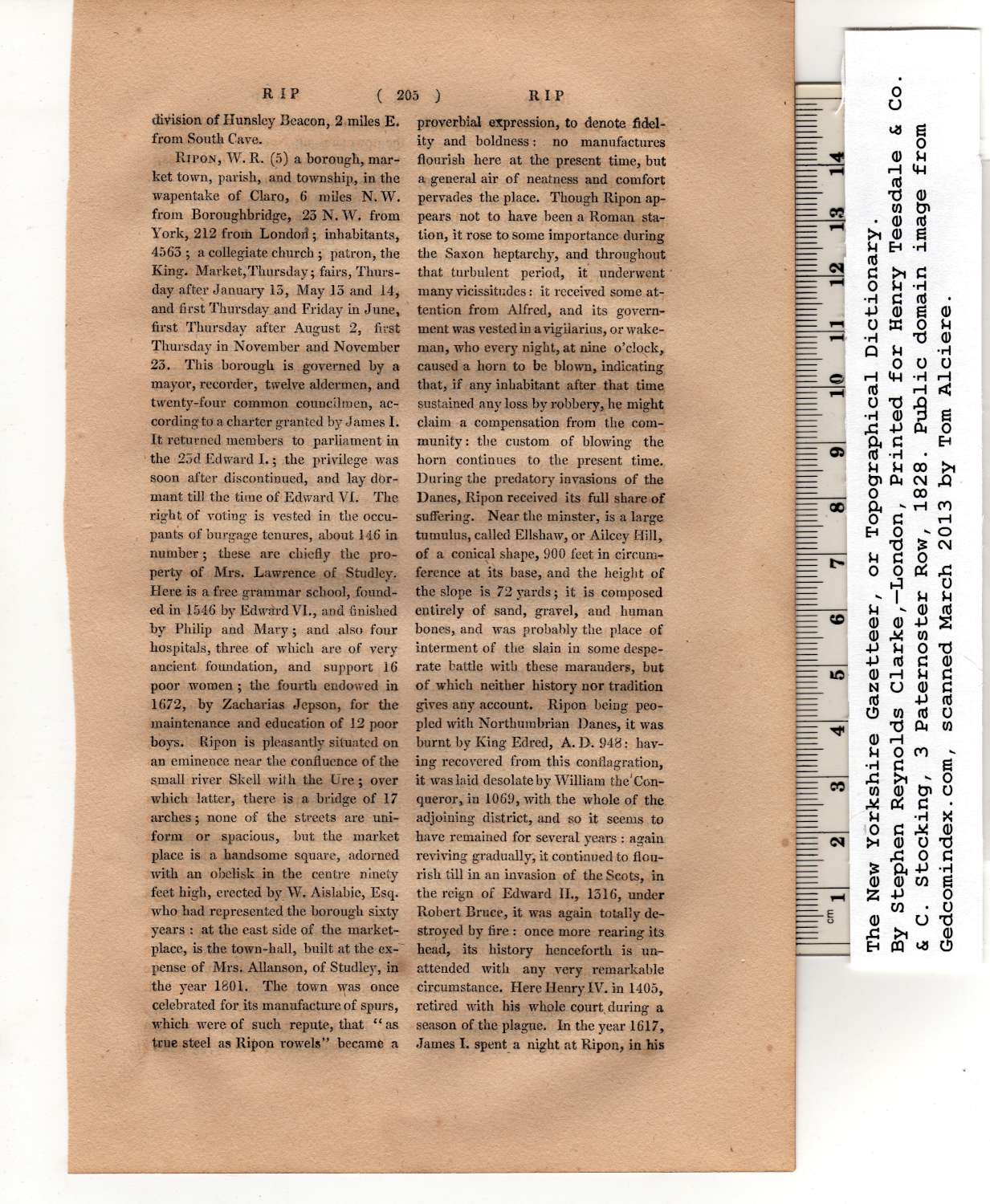|
division of Hunsley Beacon, 2 miles E.
from South Cave. |
Ripon, W. R. (5) a borough, mar-
ket town, parish, and township, in the
wapentake of Claro, 6 miles N.W.
from Boroughbridge, 25 N. W. from
York, 212 from Londori; inhabitants,
4563 ; a collegiate church ; patron, the
King. Market,Thursday; fairs, Thurs-
day after January 13, May 13 and 14,
and first Thursday and Friday in June,
first Thursday after August 2, first
Thursday in November and November
23. This borough is governed by a
mayor, recorder, twelve aldermen, and
twenty-four common councilmen, ac-
cording to a charter granted by James I.
It returned members to parliament in
the 25d Edward I.; the privilege was
soon after discontinued, and lay dor-
mant till the time of Edward VI. The
right of voting is vested in the occu-
pants of burgage tenures, about 146 in
number; these are chiefly the pro-
perty of Mrs. Lawrence of Studley.
Here is a free grammar school, found-
ed in 1546 by Edward VL, and finished
by Philip and Mary; and also four
hospitals, three of which are of very
ancient foundation, and support 16
poor women; the fourth endowed in
1672, by Zacharias Jepson, for the
maintenance and education of 12 poor
boys. Ripon is pleasantly situated on
an eminence near the confluence of the
small river Skell with the Ure; over
which latter, there is a bridge of 17
arches; none of the streets are uni-
form or spacious, but the market
place is a handsome square, adorned
with an obelisk in the centre ninety
feet high, erected by W. Aislabie, Esq.
who had represented the borough sixty
years : at the east side of the market-
place, is the town-hall, built at the ex-
pense of Mrs. Allanson, of Studley, in
the year 1801. The town was once
celebrated for its manufacture of spurs,
which were of such repute, that “ as
true steel as Ripon rowels” became a
proverbial expression, to denote fidel-
ity and boldness; no manufactures
flourish here at the present time, but
a general air of neatness and comfort
pervades the place. Though Ripon ap-
pears not to have been a Roman sta-
tion, it rose to some importance during
the Saxon heptarchy, and throughout
that turbulent period, it underwent
many vicissitudes: it received some at-
tention from Alfred, and its govern-
ment was vested in a vigilarius, or wake-
man, who every night, at nine o'clock,
caused a horn to be blown, indicating
that, if any inhabitant after that time
sustained any loss by robbery, he might
claim a compensation from the com-
munity: the custom of blowing the
horn continues to the present time.
During the predator}’’ invasions of the
Danes, Ripon received its full share of
suffering. Near the minster, is a large
tumulus, called Ellshaw, or Ailcey Hill,
of a conical shape, 900 feet in circum-
ference at its base, and the height of
the slope is 72 yards; it is composed
entirely of sand, gravel, and human
bones, and was probably the place of
interment of the slain in some despe-
rate battle with these marauders, but
of which neither history nor tradition
gives any account. Ripon being peo-
pled with Northumbrian Danes, it was
burnt by King Edred, A. D. 948: hav-
ing recovered from this conflagration,
it was laid desolate by William the' Con-
queror, in 1069, with the whole of the
adjoining district, and so it seems to
have remained for several years : again
reviving gradually; it continued to flou-
rish till in an invasion of the Scots, in
the reign of Edward II., 1316, under
Robert Bruce, it was again totally de-
stroyed by fire : once more rearing its
head, its history henceforth is un-
attended with any very remarkable
circumstance. Here Henry IV. in 1405,
retired with his whole court, during a
season of the plague. In the year 1617,
James I, spent a night at Ripon, in his |
